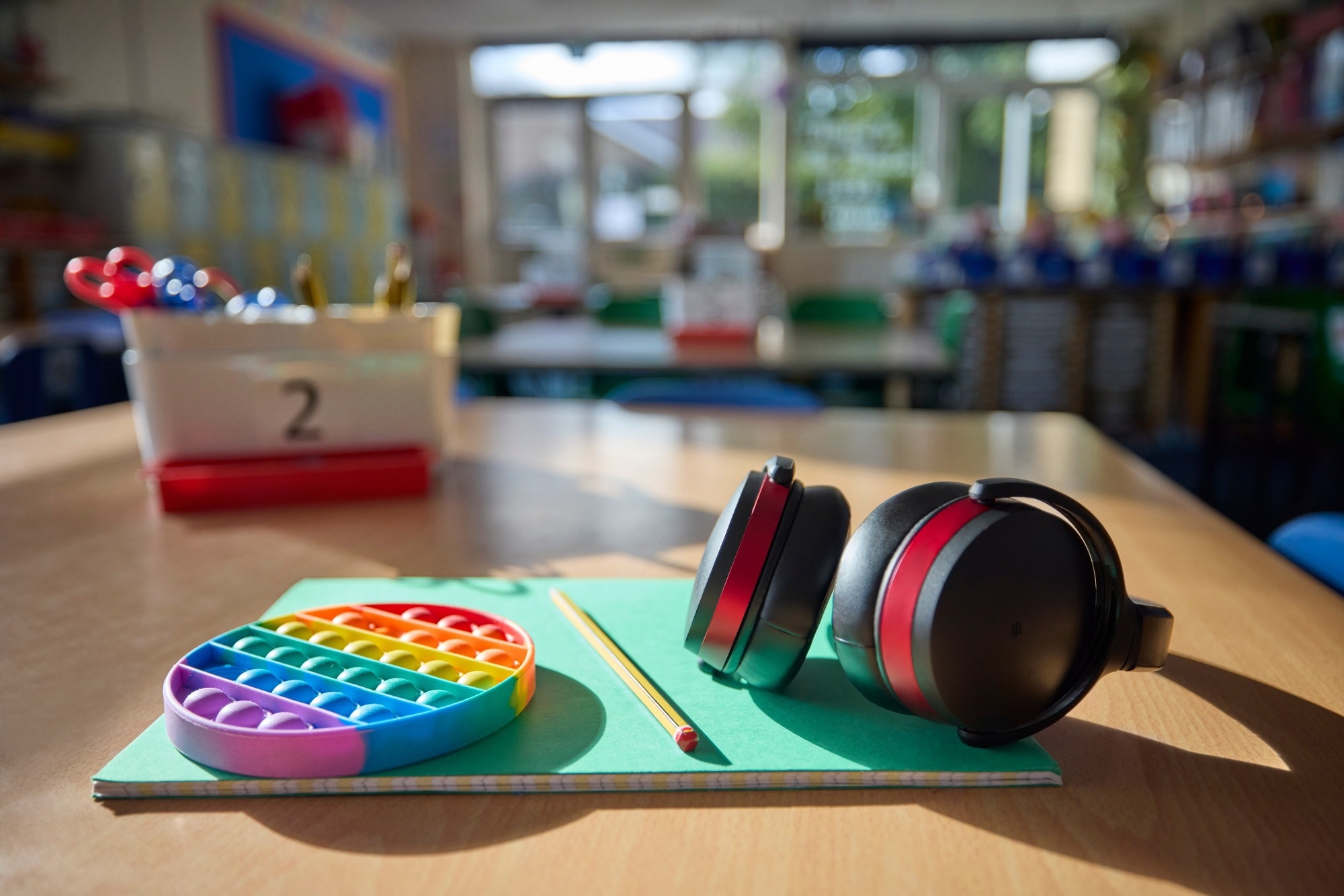Introduction
Sensory overload
Sensory seeking
Clinical assessment
Treatment and interventions
References
Further reading
 Image Credit: fizkes / Shutterstock.com
Image Credit: fizkes / Shutterstock.com
Introduction
Sensory processing differences refer to atypical ways in which the brain receives, organizes, and responds to sensory inputs such as sound, touch, light, movement, taste, and smell. In autism spectrum disorder (ASD), attention-deficit/hyperactivity disorder (ADHD), and related neurodevelopmental conditions, sensory processing differences may include hypersensitivity/over-responsivity, hyposensitivity/under-responsivity, and difficulties integrating inputs across senses.1,3
Some individuals become overwhelmed by distress, withdrawal, shutdowns, or meltdowns when input exceeds capacity, whereas others actively seek intense input by spinning, chewing, crashing, or increasing the volume to regulate arousal and attention. According to current models, such as Dunn’s Sensory Processing Framework, these contrasting responses reflect neurological thresholds for detecting input and the behavioral strategies used to maintain an optimal state of alertness.4,5 Distinguishing sensory overload from seeking is essential, as it guides environmental adaptations, communication supports, and therapy choices while preventing mislabeling behaviors as ‘noncompliance’ when they are actually self-regulation strategies.1
This article distinguishes sensory overload from sensory seeking behaviors in neurodiversity, discussing key signs, triggers, assessment tools, and interventions to inform differential diagnosis and individualized care.
Sensory overload
Sensory overload, also known as sensory over-responsivity in clinical research, refers to heightened and unusual reactions to everyday stimuli. It arises from low neurological thresholds, meaning that relatively mild sensory stimuli can trigger exaggerated neural and behavioral responses.3,4 Triggers for sensory overload can be due to touch, such as physical contact with people, fabrics, or clothing tags, and food textures, vision in the form of bright or harsh lights, loud or high-pitched noises, smell, taste, and motion sensations.2
When sensory overload occurs, stress responses are evident, as children may become emotionally upset, exhibit increased agitation, or withdraw from situations to reduce input from these sources. In some individuals, sensory overload can lead to physical aggression as a defensive reaction to overwhelming cues.2
Research on children with sensory over-responsivity suggests that these responses are associated with atypical sensory gating, reduced long-range neural connectivity, and hyperactivation of limbic areas that regulate emotions and threat detection.1
Longitudinal data indicate that preschool sensory over-responsivity predicts higher school-age anxiety symptoms. These anxiety symptoms may explain downstream problems like irritability and sleep disturbance, both of which are classic signs of chronic stress activation.2
Observable behavioral signs during or after triggering situations include shutdown behaviors such as quiet withdrawal and avoidance, meltdowns characterized by overt distress with loss of regulatory control, and aggression in the form of pushing and/or hitting when contact or sound feels intolerable.
Because sensory overload frequently co-occurs with neurodevelopmental conditions such as ASD and ADHD, early identification can reduce associated behavioral and emotional challenges.1,2,3
Multisensory environments, particularly those with bright lights, unexpected touch, or loud and high-pitched noises, are typical in schools, clinics, and public venues. Thus, it is crucial to recognize potential triggers and stress-linked behaviors to help caregivers and educators implement accommodations early. Some preventative strategies can include reducing harsh lighting, offering noise protection, and planning low-touch transitions to potentially reduce anxiety symptoms over time.2
Sensory Seeking vs Sensory Overload in Autism
Sensory seeking
Sensory seeking describes a pattern in which a child has a high threshold for detecting input and subsequently pursues additional stimulation, such as more movement, deeper pressure, and stronger tactile experiences. Within Dunn’s Sensory Processing Framework, sensory seekers actively generate additional input, which may include spinning, jumping, squeezing, or chewing to meet these thresholds and regulate arousal and attention.3
In this “sensory craving” profile, individuals appear under-reactive to typical input and may compensate through continuous movement or tactile exploration. These behaviors often enhance alertness or emotional stability rather than representing willful misconduct.3,4
Typical examples of sensory-seeking behaviors include craving vestibular and proprioceptive input, such as running or crashing into cushions, asking for tight hugs, seeking rough textures, engaging in messy play, requiring constant touch, and pressing tools or hands firmly against the skin or joints.
Sensory seekers may also mouth non-food objects or invade others’ personal space because the extra pressure, contact, and movement feel organizing. These patterns reflect the ‘craving for sensory input’ profile, which is often accompanied by reduced safety awareness when the need for input overrides risk appraisal.3
Productive options for channeling adaptive seeking behaviors include structured sports, heavy-work play, movement breaks between tasks, and deep-pressure strategies like bear hugs with consent, wall push-ups, and compression garments. Therapeutic programs may also incorporate proprioceptive and vestibular activities within sensory integration therapy to help children modulate arousal and focus attention.1,4,5
Hand-held or wearable tools, such as quiet fidgets, putty, and chew-safe jewelry, can provide ongoing tactile or oral input while maintaining attention and social participation. When integrated into routines and environments, these supports can improve regulation, persistence, and engagement without disrupting others.3
Maladaptive seeking emerges when the demand for sensory input leads to unsafe or socially disruptive behaviors like high-risk climbing, running into people, crashing furniture, chewing inedible objects, or grabbing peers for pressure. In these situations, offering the same sensory quality in safer forms with clear boundaries and co-regulated pacing is essential. Teaching self-advocacy and embedding predictable movement/pressure opportunities further reduces impulsive risk-taking while honoring the underlying sensory need.3
Clinical assessment
The most widely used questionnaires include the Sensory Profile and its updated Child Sensory Profile-2 (SP-2), which are completed by caregivers/teachers. These questionnaires summarize responses across sensory systems and Dunn’s four quadrants, including registration, seeking, sensitivity, and avoidance, while linking everyday behaviors to neurological thresholds and self-regulation styles.3,4
The Sensory Profile-2 retains this structure while adding behavior sections on conduct, attention, and social/emotional status with a scale ranging from ‘almost never’ to ‘almost always.’
These tools are practical, psychometrically vetted, and efficient for detecting modulation differences, especially in school and home contexts.3,4 Studies show that parent and teacher reports may differ across settings, emphasizing the importance of multiple informants when assessing sensory behavior in daily environments.5
For standardized multi-informant measurement across various settings, the Sensory Processing Measure offers Home, Classroom, and School Environments forms, which uniquely report social participation and praxis alongside sensory domains. Clinically, Sensory Profile and Sensory Processing Measure are used together to screen and monitor modulation profiles, with additional performance tests indicated when discrimination or praxis is suspected.3,4
The Sensory Integration and Praxis Tests assess tactile, vestibular-proprioceptive processing, visuomotor perception, bilateral integration, and praxis to evaluate discrimination/sensorimotor patterns in children between four and nine years of age. The Sensory Processing Assessment for Young Children is a semi-structured play-based observation for children up to six years of age that elicits approach/avoidance, hypo-responsivity, and defensive responses to tactile, auditory, visual, and social/non-social stimuli.3,4
 Image Credit: Daisy Daisy / Shutterstock.com
Image Credit: Daisy Daisy / Shutterstock.com
Treatment and interventions
Occupational therapists synthesize input from parents, teachers, and clinical observations to identify which sensory systems, often hearing and touch, are contributing to participation and planning challenges. Interventions then target access and regulation and may involve shifting from rapid, transient verbal teaching to clear visual supports, breaking tasks into predictable steps, and/or pacing instruction to reduce overload.5
Evidence-based sensory integration therapy and environmental modifications have been shown to improve adaptive behavior, self-regulation, and participation for children with sensory processing difficulties.1,3
In classrooms, therapists collaborate to personalize the environment by improving acoustics, minimizing competing background input, and simplifying sensory demands. These environmental adaptations reduce triggers and increase predictability, thereby allowing children to attend, plan movements, and join peers more successfully.5
Other environmental changes may include creating quieter zones for recovery, reducing unpredictable tactile contact during group work, and highlighting key instructions while reducing extraneous stimuli. Homes and schools can incorporate structured ‘low-stimulation’ spaces, such as quiet corners/rooms, for short breaks. When clinically appropriate, they can also offer deep-pressure options, like weighted blankets, under professional guidance to support calming without masking distress signals.5
References
- Patil, O., Kaple, M., & Kaple, M. N. (2023). Sensory processing differences in individuals with autism spectrum disorder: a narrative review of underlying mechanisms and sensory-based interventions. Cureus 15(10). DOI:10.7759/cureus.48020, https://www.cureus.com/articles/176734-sensory-processing-differences-in-individuals-with-autism-spectrum-disorder-a-narrative-review-of-underlying-mechanisms-and-sensory-based-interventions
- Carpenter, K. L., Baranek, G. T., Copeland, W. E., et al. (2019). Sensory over-responsivity: An early risk factor for anxiety and behavioral challenges in young children. Journal of Abnormal Child Psychology 47(6); 1075–1088. DOI:10.1007/s10802-018-0502-y, https://link.springer.com/article/10.1007/s10802-018-0502-y
- Passarello, N., Tarantino, V., Chirico, A., et al. (2022). Sensory Processing Disorders in Children and Adolescents: Taking Stock of Assessment and Novel Therapeutic Tools. Brain Sciences 12(11). DOI:10.3390/brainsci12111478, https://www.mdpi.com/2076-3425/12/11/1478
- Jorquera-Cabrera, S., Romero-Ayuso, D., Rodriguez-Gil, G., & Triviño-Juárez, J. M. (2017). Assessment of sensory processing characteristics in children between 3 and 11 years old: A systematic review. Frontiers in Pediatrics 5. DOI:10.3389/fped.2017.00057, https://www.frontiersin.org/articles/10.3389/fped.2017.00057
- Fernández-Andrés, M. I., Pastor-Cerezuela, G., Sanz-Cervera, P., & Tárraga-Mínguez, R. (2015). A comparative study of sensory processing in children with and without autism spectrum disorder in the home and classroom environments. Research in Developmental Disabilities 38; 202–212. DOI:10.1016/j.ridd.2014.12.034, https://www.sciencedirect.com/science/article/pii/S0891422214005484
Further Reading
Last Updated: Nov 6, 2025